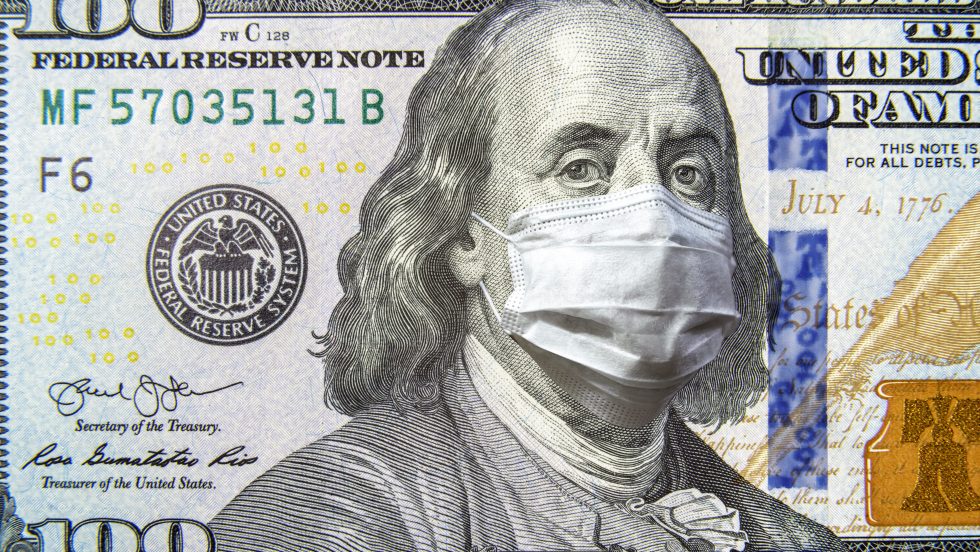
Why inflation now? What is “stagflation"? Professor of economics Mariano Torras, PhD, discusses the state of the U.S. economy.
An Interview With Professor Mariano Torras, PhD, Chair, Finance and Economics

Mariano Torras, PhD, professor and chair of finance and economics in the Robert B. Willumstad School Business.
Prices are rising at the fastest rate in two generations. There are labor shortages, supply chain issues and a new surge in COVID-19 rates. On the other hand, gross domestic product (GDP) is up, unemployment is down and wages have increased a tad. What are we to make of these conflicting signals? We asked Mariano Torras, PhD, professor and chair of finance and economics in the Robert B. Willumstad School Business, for his take on the economy and where we’re headed.
What’s up with inflation? The consumer price index rose 7 percent in 2021, the biggest 12-month increase since 1982. Is our economy in trouble?
Dr. Torras: It is quite possible. While prices are up, inflation is not remotely as bad as it was back in the late 1970s and early 1980s, when it was in the double digits. It might seem a bit of a mystery why we are having inflation now, given that the U.S. economy has been weakening, albeit slowly, for decades. While there continue to be ups and downs in the business cycle, we have been in a long-term structural economic decline due to a slow but steady fall in business and corporate investment starting in the 1950s and 1960s.
A weak economy usually means we’re less likely to see inflation, but the U.S. government has pursued expansionary policy over the past 40 years. In other words, it has run persistent budget deficits and maintained historically low interest rates for most of this period precisely to combat our continuing economic decline. Consequently, one would normally have expected moderate price increases over at least some of this period. Yet, interestingly, it has been the prices of assets like real estate and especially stocks that have gone up at a historically unprecedented rate. Goods price inflation has been virtually nonexistent. It’s almost as if the inflation that we should have expected from government expansionary policy was diverted from goods to assets.
So you’re saying inflation shouldn’t be a surprise?
Dr. Torras: It really shouldn’t. We should have long anticipated inflation because of the long-standing aggressive policy, especially on the Fed side, in hopes of keeping the economy moving.
By aggressive policy, you mean low interest rates?
Dr. Torras: Yes, low interest rates and the Fed’s purchasing of assets like bonds. The Fed has injected trillions of dollars into the global financial system. This is, in my view, a response to a prolonged stagnation that began decades ago and is perhaps not visible because of all the government efforts at stimulus.
So if our economy is stagnant and prices are rising, is this a recipe for stagflation—where the wheels come off the economy and prices rise at the same time as production falls?
Dr. Torras: Stagflation is rare. The last time the U.S. economy experienced it was in the 1970s. Yet given highly atypical conditions today, I’d say stagflation could explain what’s going on with the economy. I’m not going to go as far as to predict it; economists are notoriously deficient at making predictions. But I’d say that declaring stagflation to be at work may be consistent with the facts.
Some economists have compared the current era to the one immediately following World War II. They say COVID-19 shutdowns and supply chain disruptions are like the war in that they created pent-up demand, with more money to spend than there are goods to spend it on. Could that be a better historic economic parallel than the 1970s?
Dr. Torras: No, I wouldn’t say our current situation is like the post-World War II period. After the war, the U.S. economy was in a position of great potential. We were the strongest economy on the planet, and we were about to benefit immensely from the Marshall Plan and other ways of financing development in the other countries. We’re in a very different situation today, where we are weaker economically than some of our global neighbors. One symptom of this protracted weakness is that wages in the U.S., when adjusted for inflation, have been mostly flat for the past 50 years. If you’re looking for evidence that the U.S. economy is moribund, I’d say that flat wages are a smoking gun.
So, in this case, rising prices aren’t a sign of an improving economy?
Dr. Torras: The price increases we’re seeing now are in part due to the supply chain problems that we have been experiencing, but there is also substantial pent-up pressure on the demand side. But the demand side pressure is likely to be short-lived. To the extent that demand is heating up, it is only relative to what people experienced 12 to18 months ago—in other words, people not being able to go anywhere, not being able to spend any money, etc. So relative to that, things look like they’re growing rapidly. But it’s misleading. Nothing has happened in the past year and a half to change the long-term trend. When people ask me about COVID’s impact on the economy, I say that our economy is like a powder keg. COVID was merely the spark that ignited it. Not all of our present economic problems were caused by COVID—far from it.
So COVID-19 shined a light on existing weaknesses?
Dr. Torras: I think it’s especially shining a light on how much our economy has come to depend on finance. I use the term smoke and mirrors to describe what’s been happening, because our economy has not been a productive one for many, many years. And yet, if you look at the numbers—the stock market, for example—the numbers look more or less healthy. But much of the gain is in virtual or “fictional” wealth, where value is mostly created just on paper. And should another stock market correction come, the economy will surely feel it.
Is a market correction ahead? Do you feel tremors?
Dr. Torras: I’ve been anticipating a big correction since I was in graduate school 30 years ago, because the imbalances in the global economy even then simply did not seem sustainable. What’s shocking to me is that the party has gone on for as long as it has, since the global economy has since then grown much more unbalanced. But then again, economists are wrong much of the time, myself included.
What global imbalances do you mean?
It’s really a lot to go into here. I’d say the short answer is that for the past 40 years we’ve been concealing our economic ill-health by exploiting the privileged status of the U.S. dollar to borrow excessively and consume beyond our means. It is how we have been able to maintain high living standards in the face of weakening productivity growth. Massive borrowing explains most of our deficit and debt problems, while perennial trade deficits are the result of our insatiable appetite for imports that we cannot afford with our feeble export earnings. When experts use the term “global imbalances,” they are effectively referring to the world’s largest economy (ours) borrowing from the rest of the world to consume their exports.
What do you see happening in the next year?
Dr. Torras: The economic slowdown will persist; the U.S. economy is a shadow of what it was in the 1950s and the 1960s, and there’s no sign that’s going to change. But I think there will be continued difficulty coming to terms with that fact. I expect the government to double down on the fiscal stimulus, or at least try to in a hopelessly divided Congress. The Federal Reserve is in a real bind. If inflation continues, they will soon have to choose between combating inflation by raising interest rates and basically putting a halt to the “recovery” and crashing the markets, or just letting inflation run rampant by continuing with business as usual— in other words, low interest rates— only further delaying an inevitable readjustment of the global monetary system.
Here’s a hypothetical. You have full control of fiscal policy. What three things do you do, immediately, to strengthen the economy?
Dr. Torras: First, raise taxes on the right people. We need major tax reform in which the wealthy pay a much larger share of taxes. That way the government can raise sufficient funds to cover its spending. And we need the spending because the private sector checked out a long time ago. I don’t subscribe to the idea that taxing the wealthy and corporations will result in job loss and businesses going overseas. That is a pernicious myth. When the highest marginal income tax rate was 91 percent in the 1950s, the U.S. economy was far, far stronger, and the nation was far more stable.
And the second thing?
Dr. Torras: Use the increased tax revenue to invest in schools, energy and infrastructure. We continue to, for example, subsidize the fossil fuel companies, when we should be doing just the opposite. We should be taxing the fossil fuel companies so that we can subsidize solar and wind. We subsidize renewables to some extent now, but we should be doing much more.
And the third thing?
Dr. Torras: We need to enact some version of a universal basic income. Many researchers and scholars believe that technological change will eventually replace many, many workers. Yet people pushed out of the job market should have the right to be able to live, to at least have their basic needs covered. A UBI is feasible because it’s not an example of a means-tested policy where some could say, “That’s not fair. That’s just supporting sloth and laziness.” Everyone would receive it. Maybe $1,000 a month, who knows, the amount must be determined. But it would go to everyone. The same way everyone is eligible for Social Security benefits. It would be far superior to the welfare system we have.
Is COVID-19 going to stay in the driver’s seat in our economy this year?
Dr. Torras: I couldn’t say, and I’d be lying if I said I knew. It’s just so complex, and this whole thing so unprecedented. We’ve seen how complicated it is just trying to get the public to behave a certain way. It’s a mess, and impossible to predict. I remember around the New Year last year everyone was optimistic that 2021 was going to be so much better than 2020. And this time it seems such optimism was mostly absent. I’d say that people are nervous about what is in store for 2022.
Looking further into the future, what role might cryptocurrencies play in the economy?
Dr. Torras: This is a very difficult question to answer. The most honest answer is to say that I really do not know where they are headed. Today I see cryptocurrencies like Bitcoin mostly as speculative assets. As a form of money, on the other hand, crypto may have a future. What is hard for me to imagine is that sovereign states would allow all global money to be decentralized in a way that they cannot control. More likely, governments would take measures to “buy out” the main holders of crypto and put an end to the experiment. From there we could expect fully digital currency at some point, for better or worse. But all of this is very uncertain.